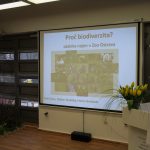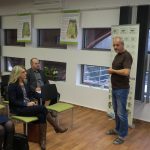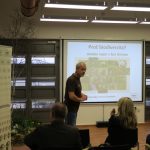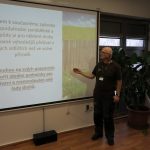Ostrava’s zoo promotes biodiversity throughout the city
 Nature and Biodiversity
Nature and Biodiversity
Ostrava’s zoo is a refuge for animals of many different kinds. Besides acting as a home for some of the world’s largest and most impressive species, the zoo also offers more modest facilities for smaller, less exotic creatures – miniature habitats for sparrows, lizards, bees, butterflies, and more…
All these small-scale facilities share a common purpose: they help support naturally occurring plant and animal populations in order to support biodiversity throughout the zoo. Director Petr Čolas explains:
“We’re not only involved in conservation work to protect species from other parts of the planet – we also care deeply about our native species which live in and around the zoo itself. In conjunction with the City of Ostrava and the Moravian-Silesian Region, we’ve launched a number of local nature conservation projects, and we’re also keen to inspire and motivate the general public to take an active interest in conservation.”
The zoo’s efforts are certainly necessary: statistics show an alarming decline in the populations of many species in recent years. This decline has not only affected bees and butterflies, but also numerous other insect species – which in turn has reduced populations of insect-eating birds. For example, during the past 40 years there has been a 95% reduction in the number of swallows living in North America! In 2017, according to a PLOS One study, there has been a 76% (!!) reduction in insect numbers in Germany during the past 27 years. Other research has revealed a 15% reduction in bird numbers in just 10 years. No detailed long-term studies of this type have yet been conducted in the Czech Republic, but there is no reason to suppose that the situation here is different.
The zoo is situated in a woodland area known as the Great Ostrava Forest (Velký ostravský les) – a unique and diverse biotope covering over 100 hectares, and a natural treasure that few zoos in the world can boast. Thanks to the character and diversity of the site, it offers an ideal habitat not only for the zoo’s animals in human care, but also for numerous naturally occurring plant and animal species. Petr Čolas adds:
“That’s why we feel it’s our duty to look after this unique space – and to pass it on to the next generation in a better condition than before.”
As part of this commitment, last year the zoo continued to expand its range of activities supporting biodiversity throughout its grounds. Staff have been involved in this type of work for many years, but last year marked a milestone, as the zoo created a complete and systematic structure to coordinate all its biodiversity activities. The zoo released substantial funding from its budget to build special habitats for plant and animal species – some of them considered at risk or endangered. During the course of 2017, staff were involved in almost 300 separate projects of this type – most of them quite simple, but potentially with major benefits to numerous species. Many of these projects are located close to the visitor routes (walkways), so members of the public will be able to see for themselves how easily we can support biodiversity in our own immediate environment, and how a variety of species (birds, amphibians, bees, butterflies, insects and invertebrates) combine to create a healthy ecosystem.
Otakar Závalský, who coordinates the zoo’s biodiversity programme and has been involved in nature conservation for over three decades, gives more details:
“The basic conditions enabling animals to survive – and that includes in urban environments – are safe access to water, sufficient food, shelter, and suitable places for reproduction.” 88% of the Czech Republic’s land area is made up of either woodland or agricultural land. Farming methods can severely reduce biodiversity (monocultures, chemical fertilizers, heavy machinery); paradoxically, some species actually find it easier to survive in areas of human settlement than in unpopulated areas. Závalský explains how people can help: “Even in their gardens at home, people can create ideal conditions for numerous species to thrive and reproduce. The most important factor – and the basis of everything – is a diverse range of vegetation. You need to create a combination of flowering and honey-bearing plants, fruit-bearing trees or bushes, and other types of trees.”
In the past two years, the zoo has planted around 12 000 trees and bushes. In 2017 staff built over 260 bunkers to substitute for hollow tree trunks – not only for small songbirds, but also for larger species such as kestrels and owls, as well as bats, bees and more. There are also three “insect hotels”, four egg-laying boxes for lizards, and three butterfly meadows. Many of these facilities have information panels for visitors, and there are some fun interactive features – such as the large wooden sculptures of beetles, which help explain the importance of dead wood for beetle populations.
In recent years, the zoo has also focused on naturally occurring reptiles and amphibians. There are numerous specially created ponds, marshy areas and other places where water is deliberately retained and drainage slowed. In 2015 the zoo opened a unique new wetland-themed nature trail, focusing on amphibians, reptiles, and other plant and animal species. Besides supporting biodiversity in wetland parts of the zoo and improving conditions so that rare plants and animals can thrive, the trail also plays a key role in raising public awareness of the critical importance of wetland habitats. Information is presented in a fun and entertaining way, with realistic (but larger-than-life) models of native reptiles and amphibians. Visitors of all ages can get “up close and personal” with these species, some of which live very secret lives and are seldom seen. Wetland areas are particularly important because they harbour some of the most biodiverse plant and animal communities on the planet. Yet they are very vulnerable to human intervention, and many wetland areas have been irreversibly damaged by human activity.
Ostrava’s Deputy Mayor Kateřina Šebestová highlights the zoo’s potential:
“Our zoo is one of the most popular tourist attractions not only in Ostrava and the region, but in the whole of the Czech Republic – so it can potentially reach a large number of people and motivate them to play their own part in nature conservation. In fact, many visitors come from nearby Poland, so the zoo could actually play an internationally significant role.”
“The largest number of wild species can be found in the zoo, but in Ostrava there are 12 protected areas where animals are thriving. These are Turkov, Štěpán, Rezavka, Polanecká niva, Poodří and others. We strive for the title of European Green Capital, so we have prepared a short film about the beauties of these territories, “said Deputy Mayor Kateřina Šebestová
[art_yt id=”kjirLSdKxhI” wvideo=”640″ hvideo=”360″ position=”center” urlvideo=”https://www.youtube.com/watch?v=kjirLSdKxhI” namevideo=”” desc=”” durationmin=”” durationsec=”” upld=”” tmburl=”https://i.ytimg.com/vi/Ogk1RAO-Z6w/maxresdefault.jpg” thumbnailwidth=”1280″ thumbnailheight=”720″]
Conservation experts from the zoo work closely alongside many other institutions. If we are to achieve real progress in nature conservation, it is essential to cooperate and involve all stakeholders in an integrated approach.
Photo: Pavel Vlček, Ostrava Zoo archives






